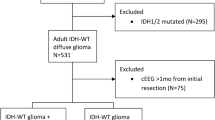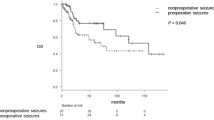Abstract
Epileptic seizures, the most common symptom accompanying glioma, are closely associated with tumor growth and patient quality of life. However, the association between glioma and glioma-related epilepsy is poorly understood. In fact, findings related to the location of epileptogenicity have been inconsistent in previous studies. We investigated seizure foci in patients with glioma and the corresponding association between glioma-related epilepsy and the tumoral and peritumoral microenvironment. Clinical characteristics, extracellular electrophysiology, immunohistochemistry, and western blots were conducted on 12 patients with glioma; nine patients had histories of preoperative seizures while three did not. Samples from included patients were used to identify seizure foci and mTOR pathway status. Electrophysiological recordings were conducted on 36 samples (tumor, peritumoral, and normal brain tissues) from 12 patients. Interictal-like discharges (ILDs) were observed in seven of nine peritumoral tissues obtained from patients with glioma that had experienced perioperative seizures. No ILDs were observed in any other sample groups. Western blots and immunohistochemistry for mTOR pathway proteins (mTOR and S6k) suggested that the mTOR pathway was activated in peritumoral tissues of patients with seizure history, but inactivated in patients without seizure history. Our results suggest that mTOR pathway expression in peritumoral tissues is associated with tumor-related seizures, thus providing a potential target for therapeutics aimed at simultaneously controlling gliomas and seizures.




Similar content being viewed by others
Abbreviations
- GAS:
-
Glioma-associated seizure
- GBM:
-
Glioblastoma multiforme
- HGG:
-
High grade glioma
- OS:
-
Overall survival
- PFS:
-
Progression-free survival
References
Armstrong TS, Grant R, Gilbert MR, Lee JW, Norden AD (2016) Epilepsy in glioma patients: mechanisms, management, and impact of anticonvulsant therapy. Neuro Oncol 18(6):779–789
Castellano A, Donativi M, Rudà R et al (2016) Evaluation of low-grade glioma structural changes after chemotherapy using DTI-based histogram analysis and functional diffusion maps. Eur Radiol 26:1263–1273. doi:10.1007/s00330-015-3934-6
Citraro R, Leo A, Constanti A, Russo E, De Sarro G (2016) mTOR pathway inhibition as a new therapeutic strategy in epilepsy and epileptogenesis. Pharmacol Res 107:333–343. doi:10.1016/j.phrs.2016.03.039
Huberfeld G, Vecht CJ (2016) Seizures and gliomas—towards a single therapeutic approach. Nat Rev Neurol 12:204–216. doi:10.1038/nrneurol.2016.26
Jiang T, Mao Y, Ma W et al (2016) CGCG clinical practice guidelines for the management of adult diffuse gliomas. Cancer Lett 375:263–273. doi:10.1016/j.canlet.2016.01.024
Li X, Wu C, Chen N, Gu H et al (2016) PI3K/Akt/mTOR signaling pathway and targeted therapy for glioblastoma. Oncotarget. doi:10.18632/oncotarget.7961 (Epub ahead of print)
Lim JS, Kim WI, Kang HC et al (2015) Brain somatic mutations in MTOR cause focal cortical dysplasia type II leading to intractable epilepsy. Nat Med 21:395–400. doi:10.1038/nm.3824
Lipton JO, Sahin M (2014) The neurology of mTOR. Neuron 84:275–291. doi:10.1016/j.neuron.2014.09.034
Pallud J, Le Van Quyen M, Bielle F et al (2014) Cortical GABAergic excitation contributes to epileptic activities around human glioma. Sci Transl Med. doi:10.1126/scitranslmed.3008065
Pallud J, Capelle L, Huberfeld G (2013) Tumoral epileptogenicity: how does it happen? Epilepsia 54(Suppl 9):30–34. doi:10.1111/epi.12440
Ruda R, Bello L, Duffau H, Sofietti R (2012) Seizures in low-grade gliomas: natural history, pathogenesis, and outcome after treatments. Neuro Oncol 14(Suppl 4):iv55–iv64. doi:10.1093/neuonc/nos199
Su X, Chen HL, Wang ZY, Lan Q (2015) Relationship between tumour location and preoperative seizure incidence in patients with gliomas: a systematic review and meta-analysis. Epileptic Disord 17:397–408. doi:10.1684/epd.2015.0788
Takeuchi S, Wada K, Toyooka T et al (2013) Increased xCT expression correlates with tumor invasion and outcome in patients with glioblastomas. Neurosurgery 72:33–41. doi:10.1227/NEU.0b013e318276b2de (discussion 41)
Venkatesh HS, Johung TB, Caretti V et al (2015) Neuronal activity promotes glioma growth through neuroligin-3 secretion. Cell 161:803–816. doi:10.1016/j.cell.2015.04.012
Wang Y, Qian T, You G et al (2015) Localizing seizure-susceptible brain regions associated with low-grade gliomas using voxel-based lesion-symptom mapping. Neurol Oncol 17:282–288. doi:10.1093/neuonc/nou130
Wen PY, Reardon DA (2015) Progress in glioma diagnosis, classification and treatment. Nat Rev Neurol 12(2):69–70
You G, Sha ZY, Yan W et al (2012) Seizure characteristics and outcomes in 508 Chinese adult patients undergoing primary resection of low-grade gliomas: a clinicopathological study. Neuro Oncol 14:230–241. doi:10.1093/neuonc/nor205
Yuan Y, Peizhi Z, Maling G et al (2015) The efficacy of levetiracetam for patients with supratentorial brain tumors. J Clin Neurosci 22:1227–1231. doi:10.1016/j.jocn.2015.01.025
Yuan Y, Xiang W, Qing M et al (2014) Survival analysis for valproic acid use in adult glioblastoma multiforme: a meta-analysis of individual patient data and a systematic review. Seizure 23:830–835. doi:10.1016/j.seizure.2014.06.015
Acknowledgements
This study was supported by funds from the Sichuan Province Science and Technology support plan (No. 0040205301B13 and 0040205301C38).
Author information
Authors and Affiliations
Corresponding authors
Ethics declarations
Conflict of interest
The authors declare that they have no conflict of interest.
Rights and permissions
About this article
Cite this article
Yuan, Y., Xiang, W., Yanhui, L. et al. Activation of the mTOR signaling pathway in peritumoral tissues can cause glioma-associated seizures. Neurol Sci 38, 61–66 (2017). https://doi.org/10.1007/s10072-016-2706-7
Received:
Accepted:
Published:
Issue Date:
DOI: https://doi.org/10.1007/s10072-016-2706-7




